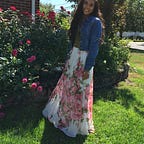The History of Flapper Fashion
Flappers are one of the most misrepresented groups in history. Their appearance was a response to the changing environment around them. Fashion was influenced by the war, jazz music and so much more. Many looked down upon them, not knowing their true meaning and everything that they stood for. Some people even consider Flappers as the start of feminism. They are an important part of history that are often left out. In this post I am going to explain a little bit of the creation of Flappers and a description of their appearance.
Flappers loved jazz music and it turned them into “new women”. They embodied the modern spirit that this era created and propelled it further. Jazz rose to popularity during the time of prohibition in speakeasies. This is also why the Jazz Age is referred to as the Roaring Twenties. Jazz differed from prior music due to its origins within the African-American community. Jazz promoted individual freedom with improvising. This connected with flappers who did not want to conform to society. The younger generation, including flappers, were going crazy for dances like the Charleston and the Lindy Hop while the older generations did not understand the significance of jazz and continued to do the waltz and the foxtrot. At first, jazz was considered the “Devils’ Music,” until it was appreciated for the art that it is. Dancing became more risqué during this time. The early jazz music was wild and exciting dance music, which was reflected in the fashion. Music spoke to the flappers’ free spirit and desire to change societal norms.
Through fashion, flappers expressed their emotions. Flappers adopted the “garconne” or little boy look. This style deemphasized the mature female form by flattening the chest, dropping waistlines to hips and shorting the hems of skirts and dresses.
This is also where the staple in every woman’s closet, the little black dress, came from. Before the 1920s, black was not commonly worn because it was associated with mourning and death. This view of black changed with Coco Chanel. Chanel published a simple, short black dress in a Vogue in 1926. The dress was “Chanel’s Ford,” it was accessible to women of all social classes, similar to the Model T vehicle. This dress was popular then, and even today, because it is so versatile and does not cost a lot to look put together. The little black dress represents everything that women were told they couldn’t be or couldn’t look like.
Young women also ditched their corsets to be comfortable when dancing to jazz music. Corsets were a major component of the female image, as demonstrated by a “Gibson Girl”. Victorian ideals controlled the behavior of American women and girls. Flapper dresses were boxy and showed no shape of a woman. They wanted to prove that they were more then just what they looked like on the outside.
Flappers gave conservatives a shock by cutting their hair short and wearing makeup. This was a major difference between the Gibson girl and a flapper. Long hair was a sign of a respectable lady before the war, but flappers decided that it was time for a change.
Prior to the 1920s, cosmetics were associated with prostitutes and actresses. Flappers believed that it was glamorous to wear dark lipstick, lots of blush or rouge, and eyeliner around their eyes. Makeup brands such as Maybelline began to emerge at this time.
Towards the end of the 1920s, the flapper culture started to fade out. Their lifestyle itself fell when the economy crashed and the Great Depression ensued. Traditional morality resurfaced towards the end of the 1920s in the United States, which reflected the decline. All of the misrepresentation in the media over the years finally caught up to society.
Flappers left behind not only a legacy for the fashion world but also a legacy for the entire world. Flappers created a new foundation for the modern women that departed from Victorian values. They were misrepresented in our history. These young women used the forward-thinking concept of the modern woman to initiate change in society for how all women were viewed. It is not mentioned enough that they had roots in the beginnings of the feminist movement and how much positivity over negativity they brought. I remember when I was a little girl, for Halloween I loved to dress up as a flapper. The flapper culture still lives on and will continue too.
